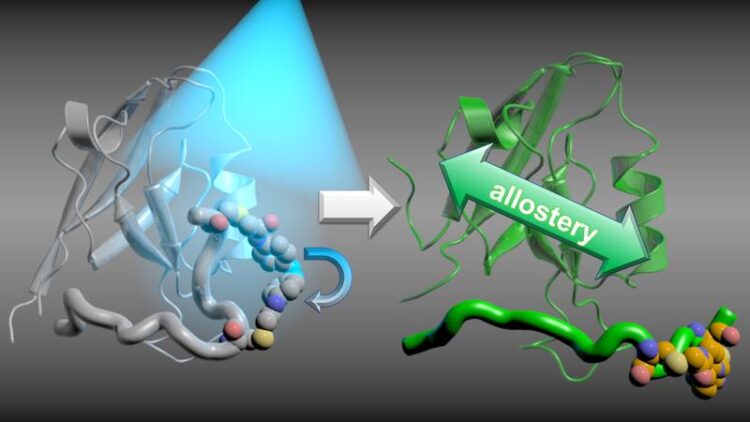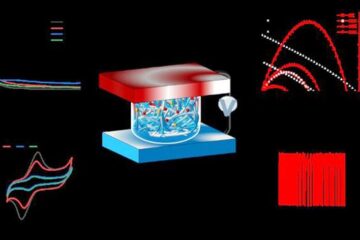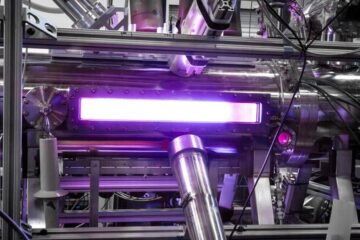Breaking the coupling process

Informationen der Proteine: Eine Unterbrechung in diese Kopplung, der Allosterie, führt dazu, dass Signale nicht weitergeleitet werden.
Abbildung: Gerhard Stock, Steffen Wolf
Real-time observation of signal transmission in proteins provides new insights for drug research.
Proteins transduce information and signals within the human body by changes in their structures. For example, hormones binding to their target proteins cause a structural change which in turn opens new binding sites for other proteins elsewhere on the surface of the protein. Researchers refer to this coupling of different, distant binding sites as allostery. An interruption of this coupling leads to signals not being passed on.
This can be achieved by molecules specifically designed for this purpose, which thereby obtain pharmacological effects as analgesics or chemotherapeutic agents. To selectively design such molecules, scientists need to learn more about the possible mechanisms of allostery.
A team led by Prof. Dr. Gerhard Stock from the Biomolecular Dynamics group at the Institute of Physics at the University of Freiburg and Prof. Dr. Peter Hamm from the Institute of Chemistry at the University of Zurich, Switzerland provides important insights into the molecular details of allostery in the journal PNAS.
The researchers tracked time-resolved allosteric changes in the test protein PDZ2, which are caused by the binding of a peptide ligand. To this end, the research group at the University of Zurich performed time-resolved vibrational spectroscopy, while the physicists at the University of Freiburg simulated the corresponding changes on an atomistic level using the bwHPC cluster BinAC at Tübingen.
This combination enabled the scientists to understand how a change in the ligand binding mode induces protein structure changes passing through the protein with atomic resolution and a time scale range from picoseconds to microseconds.
The real-time observation of signal transduction in proteins showed that allostery is based on changes in both the structure and dynamics of the protein, which exhibits hierarchical dynamics, where a structural change takes about ten times longer than a preceding change.
Original publication:
Bozovic, O., Zanobini, C., Gulzar, A., Jankovic, B., Buhrke, D., Post, M., Wolf, S., Stock, G., Hamm, P. (2020): Real-time observation of ligand-induced allosteric transitions in a PDZ domain. In: PNAS. DOI: 10.1073/pnas.2012999117
Contact:
Prof. Dr. Gerhard Stock
Institute of Physics
Faculty for Mathematics and Physics
University of Freiburg
Tel.: 0761/203-5750
gerhard.stock@physik.uni-freiburg.de
Originalpublikation:
https://www.pnas.org/content/early/2020/10/02/2012999117
https://www.pr.uni-freiburg.de/pm-en/press-releases-2020/breaking-the-coupling-process
Media Contact
All latest news from the category: Life Sciences and Chemistry
Articles and reports from the Life Sciences and chemistry area deal with applied and basic research into modern biology, chemistry and human medicine.
Valuable information can be found on a range of life sciences fields including bacteriology, biochemistry, bionics, bioinformatics, biophysics, biotechnology, genetics, geobotany, human biology, marine biology, microbiology, molecular biology, cellular biology, zoology, bioinorganic chemistry, microchemistry and environmental chemistry.
Newest articles

Superradiant atoms could push the boundaries of how precisely time can be measured
Superradiant atoms can help us measure time more precisely than ever. In a new study, researchers from the University of Copenhagen present a new method for measuring the time interval,…

Ion thermoelectric conversion devices for near room temperature
The electrode sheet of the thermoelectric device consists of ionic hydrogel, which is sandwiched between the electrodes to form, and the Prussian blue on the electrode undergoes a redox reaction…

Zap Energy achieves 37-million-degree temperatures in a compact device
New publication reports record electron temperatures for a small-scale, sheared-flow-stabilized Z-pinch fusion device. In the nine decades since humans first produced fusion reactions, only a few fusion technologies have demonstrated…





















